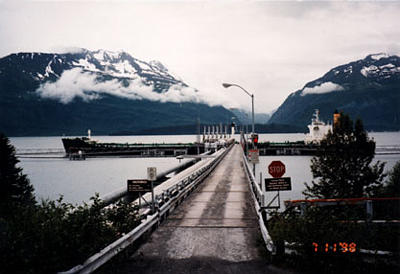
|
|
11 July, 1998
Myrtle Brijbasi
TEA/Alaska - 98
Journal Entry 2 - July 11, 1998
Travel to Anchorage, AK
After a few hours of restful sleep, I woke up to drizzling rain. It was
dull and chilly, 46 degrees. At about 9 am, we checked out of the hotel
and headed to the Natural History museum where we planned to spend the
morning. After having a light breakfast there, we toured the museum.
Our focus was the native Alaskans. Their sense of technology was phenomenal
even though their life style was very primitive. I was amazed at their
garment designs and their tailoring skills to make the water proof parkas.
No modern day serger can compare to the seams that they produced by hand,
and its ability to repel water. The grass material used as thread and the
gut of the animals were capable of swelling in water and sealing the
needle holes. The social structure of the different native and immigrant
groups was also very interesting and unique. We were able to visit the
exhibits of the newcomers to Alaska and their influence on the lifestyle of
indigenous Alaskans - explorers, the fur traders, the gold rush
opportunists, the Alaska railroad and pipeline workers. This was very
enlightening.
From the museum, we went to the airport for departure to Valdez . There
we saw a small exhibit on Arctic/Alaskan bears prior to boarding the small
aircraft. The flight was short and sweet (35 minutes), and we were treated
hospitably. From the airport we drove to the Westmark hotel. It
overlooked the Valdez marina, the backdrop of which were beautiful
ice-capped mountain ranges. After checking in, we went to lunch at a
quaint "mom & pop" restaurant, had a lovely meal, and took Valdez for
ourselves. We walked around, visited a number of gift shops, stores, air
marked dinner possibilities, then visited the Valdez museum. This was
small, but very interesting. It highlighted the history of Valdez, city
legends, and of course the mighty Alaska pipeline.
Following the museum visit, we took a bus tour to the Alaska Pipeline.
Historical facts as well as some very interesting "tales" of Valdez were
shared with the us - tourists. As we traveled along the tour route,
incidental information was also given on the old Valdez which was destroyed
by the earthquake, and the relocation of the new Valdez. As we entered the
high security area of the Pipeline, we were greeted by a huge billboard
which displayed all of the related facts and quantitative data of
operations since its inception. We visited each of the berths, from
which barges are loaded, and detailed explanations were given of the day to
day operations. Precautionary measures which were implemented since the
Exxon Valdez spill, were emphatically explained, since Alaska does not
want to ever experience such a disaster again. Spills are minimized to
less than a table spoon of crude oil for every barge that is loaded
Because it was a bus tour, and for security reasons, we could only
disembark at specific locations to walk around. The only part of the
operation we were actually able to witness was the cleaning of the tanks
for the water treatment process, and the tanks where the oil eating
bacteria are cultured for the cleansing process. The lay out the physical
plant was explained - floating docks, insulation of the above ground
pipelines and their relative heights, positions/locations of the specific
buildings, holding tanks, security cameras, transmitting and communication
stations, retaining walls, fire stations, and the like. The design of
this plant is well thought out., and systems of operation very fascinating.
The tour ended at the 799 mile mark(800) where the huge, well insulated,
above-ground pipeline disappears underground.
On our return trip to the bus terminus where the tour originated, we
noticed several people fishing, and some very successful fishermen proudly
displaying their day's catch. At the terminus we watched a video on the
Alaskan Pipeline, and viewed a few exhibits on the pipeline. This is done
before or after the tour - tourist's choice. We went back to the hotel
and then to dinner - a tasty meal of halibut . The biggest joke of the
day was when our waiter was distracted and completely missed the glass and
poured water on to the table. That was the last we saw of him that
evening. Tomorrow will be a long, but much anticipated day. We will
travel the scenic route to Seward via ferry to Whittier, on to Portage by
train, and then drive to Seward. So join me for another wonderful day in
the last frontier.
*************************************************
Stephanie Shipp
Department of Geology (713) 285-5168
& Geophysics MS126 (713) 285-5214 fax
Rice University shippst@ruf.rice.edu
Post Office Box 1892
6100 South Main
Houston, Texas 77005
*************************************************

This tanker rides low in the water after being filled with crude oil from the pipeline.

Valdez Terminal-Berth 1
Contact the TEA in the field at
.
If you cannot connect through your browser, copy the
TEA's e-mail address in the "To:" line of
your favorite e-mail package.
|
